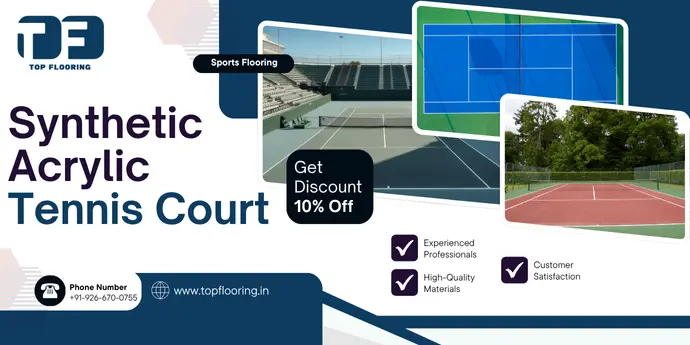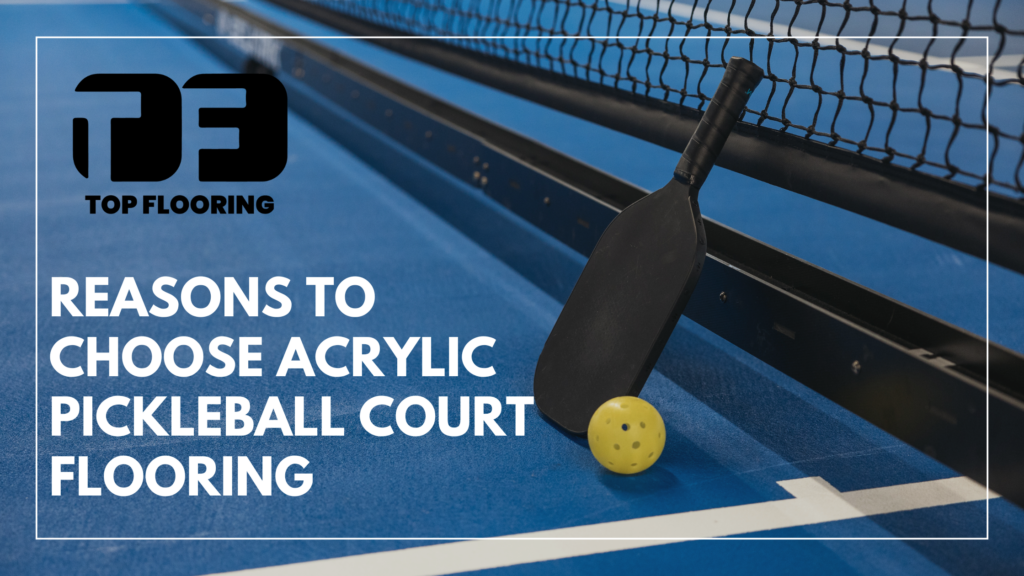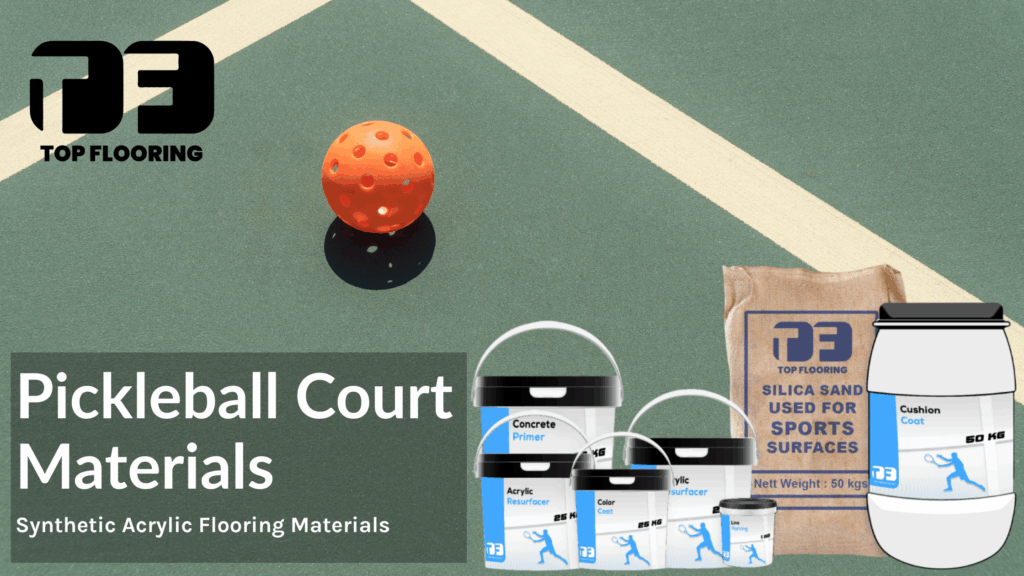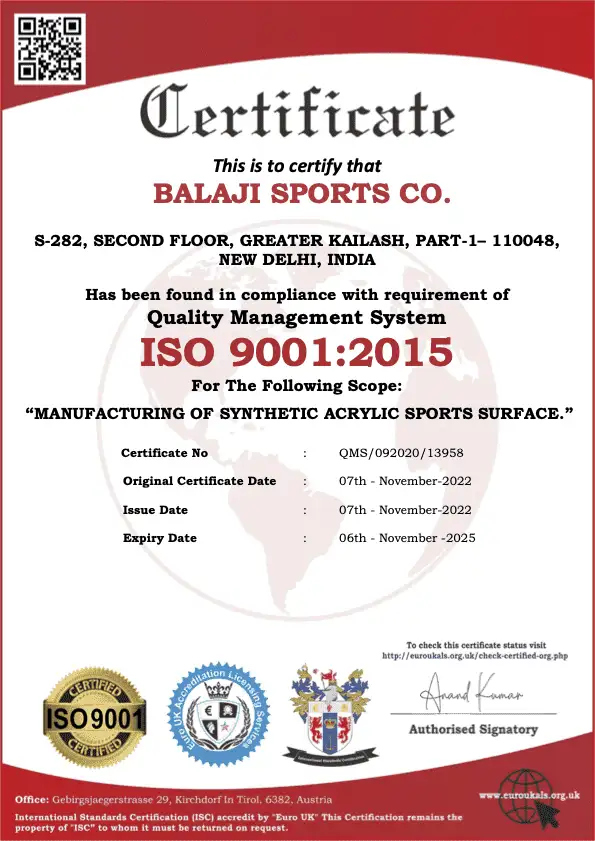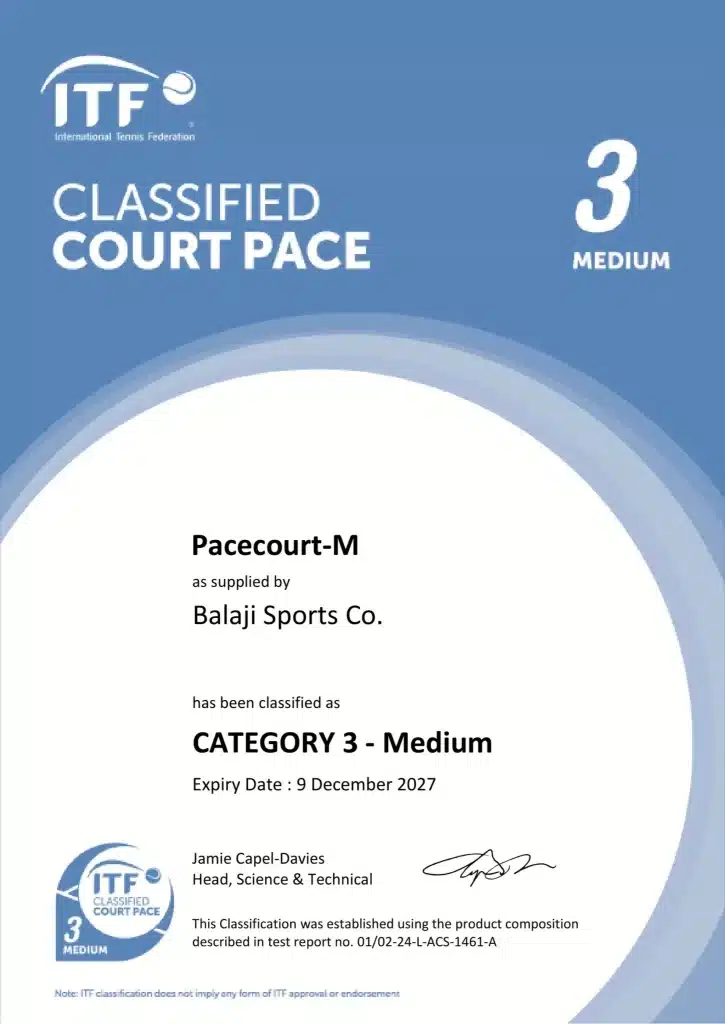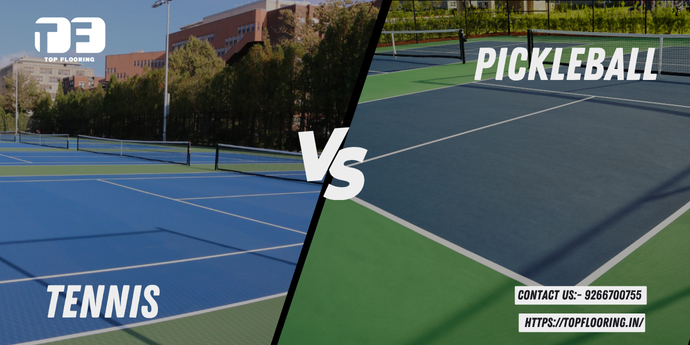
In India’s fast paced sports landscape, tennis and pickleball are two of the most popular racket sports—but couldn’t be more different in terms of scale, speed and space. While tennis is a game of strength and precision. And pickleball has become a favorite for communities looking for a fast paced sport that fits in limited space. As more clubs, schools and housing societies plan new courts, one common question arises: What exactly is the difference between a tennis court vs pickleball court?
This in-depth guide breaks down every aspect from dimensions and space requirements to kitchen zones, construction costs and combination layouts. The goal is not just to compare but help decision makers plan smartly when investing in sports infrastructure. At Top Flooring, India’s leading name in synthetic acrylic sports flooring, we have supplied materials for both tennis and pickleball courts across schools, academies and residential clubs across India. By combining years of on-ground experience with world-class coating technology. We understand the practical and technical aspects that distinguish one sport’s surface from another.
So let’s dive in and understand which sport’s court fits your space, budget with long term vision.
1. Tennis Court vs Pickleball Court: Understanding the Size Difference
The most visible difference between a tennis vs pickleball court begins with their size and scale. A standard tennis court size is 78 feet in length and 27 feet wide for singles or 36 feet wide for doubles. Including the outer buffer zones, the total area is nearly 120 feet by 60 feet, amounting to around 7,200 square feet. This large area allows players to run wide, play long rallies and cover a lot of ground during matches.
A pickleball court is much more compact, just 44 feet long and 20 feet wide, with a recommended surrounding space of 60 feet by 30 feet, giving a total area of about 1,800 square feet. That’s roughly one-fourth the size of a tennis court. The smaller layout makes it easier to install on terraces, in smaller societies or even as a recreational corner inside school compounds.
The gameplay reflects these differences: tennis demands strength, movement and strategic baseline play, while pickleball requires reflexes, quick exchanges and softer paddle control.
| Feature | Tennis Court | Pickleball Court |
| Total Length | 78 ft | 44 ft |
| Width | 36 ft (doubles) | 20 ft |
| Area (approx.) | 3,780 sq. ft | 880 sq. ft |
| Recommended Space | 120 × 60 ft | 60 × 30 ft |
| Net Height (center) | 36 in | 34 in |
| Suitable Flooring | Acrylic, Synthetic | Acrylic, Synthetic |
Because of the huge difference in size. You can fit four pickleball courts in one tennis court. A fact that has changed how clubs all over India are using their existing tennis facilities.
2. How Much Space Do I Need for a Pickleball Court?
When planning to build a pickleball court, it’s not just about drawing a 44×20-ft rectangle. To meet safety and comfort standards, you need to include free zones around the court where players can move freely and safely during rallies.
The official playing area of a pickleball court is 44 feet by 20 feet. But the recommended construction space should be at least 60 feet by 30 feet. This buffer provides 10 feet behind each baseline and 5 feet on each sideline important for preventing injuries and maintaining court balance.
For outdoor pickleball court installations, you need to plan for 1% surface slope and side drainage to avoid water accumulation. For indoor setups, ceiling clearance should be no less than 18–20 feet to allow high lobs and overhead shots without obstruction.
At Top Flooring, many projects in residential societies and schools have used innovative space planning to fit two pickleball courts in a standard badminton-court-sized hall or build rooftop courts with custom safety fencing and acrylic coatings. Our experts assess soil strength, existing surface flatness and local climate before recommending the right layer system—so every square foot delivers optimal bounce and comfort.
This space optimization is one reason why pickleball is India’s go-to sport for compact recreational development projects.
3. Is a Pickleball Court the Same Size as a Tennis Court?
A quick glance might mislead some to think both courts are the same because they are rectangular and have a net. But pickleball courts are much smaller and even the net height and layout lines are different.
A tennis net is 3.5 feet at the posts and 3 feet at the center, while a pickleball net is 36 inches high at the sides and 34 inches in the middle lower to accommodate soft and faster volleys. The non-volley zone (kitchen) and service boxes in pickleball are completely different from the service zones in tennis. These differences make pickleball more accessible and space-efficient. That’s why many academies in India are converting old tennis courts into multi-purpose courts with different line markings for both sports.
Top Flooring suggests using different line colors white for tennis and yellow or blue for pickleball to make the markings clear. Our acrylic coatings retain sharp edges and bright colors even with heavy usage and harsh sun, looking professional for years.
4. Pickleball Court vs Tennis Court: Functionality and Gameplay
Beyond tennis court vs pickleball court size, the design philosophy of each sport’s court is different. A tennis court supports long rallies, top-spin shots, and baseline endurance. Players move a lot and therefore surfaces need to provide grip and shock absorption. That’s why multi-layer acrylic systems are preferred. Because they offer consistent bounce, water resistance and player safety.
Pickleball demands quick footwork and controlled dinking near the net. Since the play area is smaller, surface uniformity is even more critical. A slightly uneven or slippery area can disrupt the rally. Acrylic flooring with textured grip and resilient underlayers provides the perfect balance of speed and comfort.
Top Flooring’s ITF-approved coating system involves multiple stages: concrete primer, acrylic resurfacer, cushion coats, color coats and line marking. This structure gives true bounce for tennis balls and paddle responsiveness for pickleball—making it an ideal shared surface for both sports.
5. The Pickleball Court Kitchen Size
The kitchen is the most distinctive feature of pickleball courts and one element that doesn’t exist in tennis at all. The kitchen, officially called the non-volley zone (NVZ), is 7 feet from the net on both sides and covers the entire 20 foot width of the court. Players can’t volley (hit the ball in mid-air) while standing inside this zone. They can only step into it after the ball bounces once.
This changes how rallies play out—forcing players to focus on precision, placement and tactical control instead of power hitting. The kitchen turns pickleball into a game of finesse and patience. When marking the kitchen area, Top Flooring uses high-visibility acrylic paints that won’t fade and ensures line clarity even in outdoor sunlight. Kitchen dimensions are crucial during construction; even a small movement might have an impact on player experience and fairness.
6. How many Pickleball Courts can fit on a Tennis Court?
This is one of the most common and practical questions from facility owners. The answer: up to 4 pickleball courts can fit comfortably inside one standard tennis court.
The layout generally follows two approaches:
- Two-Court Conversion – If tennis lines are retained, two pickleball courts can be placed side by side on the existing surface, using the full width but shorter length.
- Four-Court Layout – If tennis is not required, four pickleball courts can be aligned within the tennis boundaries, each around 60 ft × 30 ft including buffer zones.
This is very cost effective for clubs or schools looking to add a new sport without major space investment.
Top Flooring provides combination marking templates to help clients see both sports on one surface. The courts are color coded and portable nets allow for quick conversion.
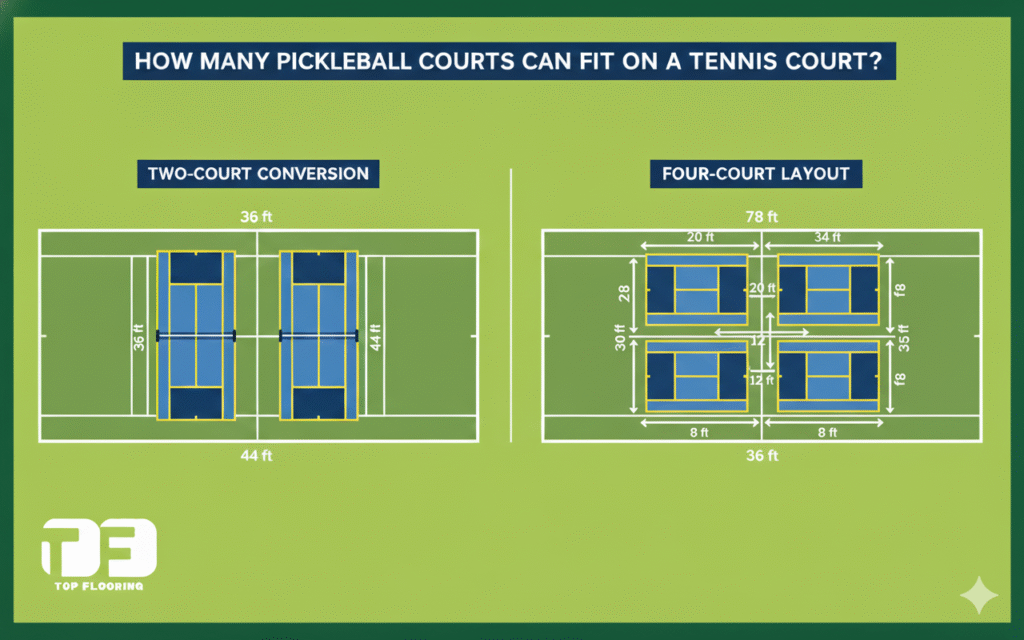
7. Combination Tennis and Pickleball Courts
As sports evolve, combination courts where both tennis and pickleball can be played on the same surface. Which are getting more popular and is something different from tennis court vs pickleball court. These courts use most of the space and serve multiple demographics.
A combination court has:
- Standard acrylic surface system compatible with both sports.
- Dual colored lines: white for tennis, yellow or blue for pickleball.
- Adjustable or removable nets, sometimes with center straps for dual use.
This way clubs can have morning pickleball sessions and evening tennis matches on the same court. In housing societies where one playground has to serve multiple sports, combination layouts are unbeatable.
Top Flooring specializes in such multi-sport designs, using precise CAD layouts and color coded drawings to ensure compliance with ITF and USA Pickleball standards.
8. Cheapest Way to Build a Pickleball Court
Not everyone has the budget for new construction. But with smart planning you can still have a professional grade court affordably. The cheapest way to build a pickleball court is to repurpose an existing flat surface—like a tennis, basketball or concrete play area.
Here’s a cost effective way Top Flooring often recommends:
- Inspect the Existing Base: If the surface is level, free of major cracks and structurally sound, it can be reused.
- Apply Acrylic Resurfacer: A resurfacer smooths out imperfections and provides adhesion for further coats.
- Use Non-Cushioned Acrylic System: While cushioned floors are better, non-cushioned systems are much cheaper.
- Add Sand-Textured Color Coats: These provide slip resistance and durability.
- Install Portable Net Posts: Movable nets save installation costs and add flexibility.
Using this method community projects and small academies can set up courts in ₹2.5–3 lakh—almost one-fourth the cost of a full tennis setup. Even with limited budgets they can have world class playing quality when using Top Flooring’s acrylic materials designed for Indian climate conditions.
9. How Much Does It Cost to Put in a Pickleball Court?
The total pickleball court construction cost varies depending on the base type, number of acrylic layers and optional cushioning.
Here’s an approximate breakdown for India:
| Component | Description | Cost Range (INR) |
| Concrete or Asphalt Base | Level foundation with 1% slope | ₹1.2–1.8 lakh |
| Acrylic Resurfacer | Base leveling coat | ₹40,000–₹60,000 |
| Color Coats | 2–3 textured acrylic coats | ₹60,000–₹90,000 |
| Line Marking | Long-lasting acrylic paint | ₹10,000–₹15,000 |
| Net System | Fixed or portable setup | ₹25,000–₹40,000 |
| Total | — | ₹2.5–3.5 lakh |
Premium cushioned systems can go up to ₹4.5–5 lakh, more shock absorption and professional grade comfort. Even then pickleball is a very affordable sport to introduce in any facility compared to tennis courts which cost ₹7–12 lakh.
10. How Big Is a Pickleball Court Compared to a Tennis Court?
To understand the scale difference imagine a pickleball court inside a tennis court. A standard tennis court including buffer zones is around 7,200 square feet and a pickleball court with safety margins is around 1,800 square feet. So a single tennis court can accommodate four pickleball courts without any crowding or overlap.
This size difference brings many practical advantages. Pickleball courts require less construction material, less time to install and lower maintenance and resurfacing costs over time. For schools, clubs and residential communities this is a perfect choice for high engagement in limited space.
Top Flooring’s design specialists work with architects and planners to create multi-use acrylic surfaces that integrate pickleball with other sports like badminton, basketball or futsal—all on a single synthetic base. The result is a modern, colorful and cost effective facility that maximizes play area while maintaining professional standards.
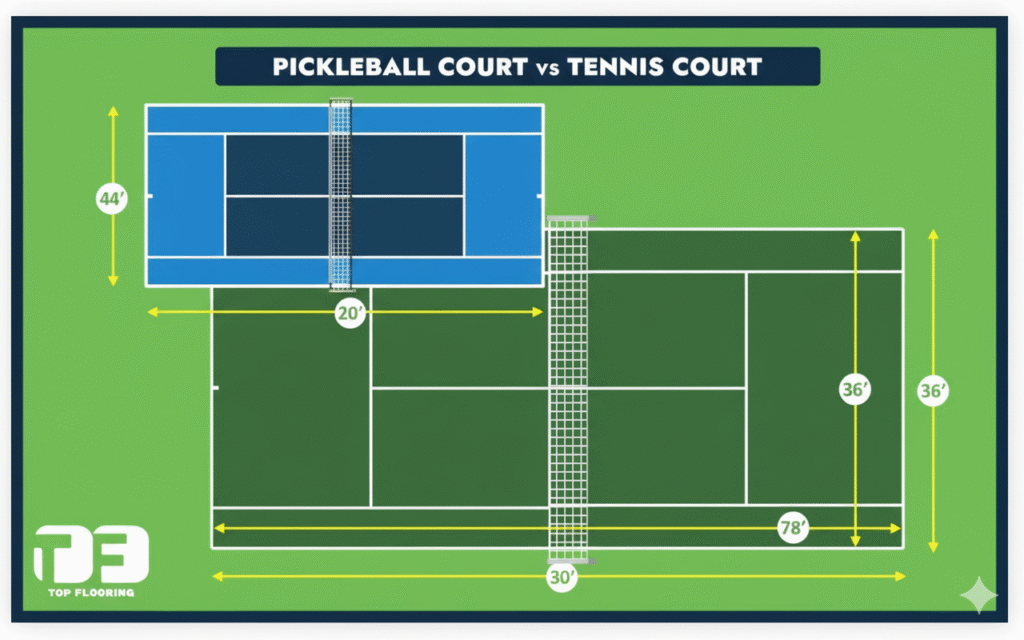
11. Why Acrylic Flooring Is Ideal for Both Tennis and Pickleball
Surface material plays a big role in player safety and performance. Both tennis and pickleball demand predictable bounce, slip resistance and color stability—and acrylic flooring meets all these requirements.
Key Benefits:
- All-Weather Performance: Withstands heat, humidity and rain without cracking or fading.
- Uniform Texture: Prevents uneven bounce and provides consistent friction.
- Easy Maintenance: Only requires basic washing and periodic re-coating every few years.
- Aesthetic Appeal: Vibrant, UV stable colors enhance court visibility and brand image.
Top Flooring’s ITF certified acrylic systems are available in both cushioned and non-cushioned variants, so clients can choose based on usage intensity and budget. Each layer—Primer and Resurfacer to Cushion Coat and Color Coat—is formulated to deliver professional results even under extreme Indian weather.
12. Dual Tennis–Pickleball Facility
As spaces shrink and sports grow, the concept of dual purpose courts is gaining momentum in India. A tennis–pickleball combo court is the perfect balance of performance, versatility and value. It allows one surface to host traditional tennis matches and fast paced pickleball sessions, so every square inch of space is used throughout the day.
The process starts with measuring the existing tennis layout which is usually around 120 feet by 60 feet. Within this space you can overlay 2 or 4 pickleball courts depending on the orientation and buffer zones. Careful alignment ensures both sets of markings are visible and compliant with their respective standards—white lines for tennis and yellow or blue lines for pickleball so there’s no visual confusion.
Next is installing an adaptable net system. In many modern facilities portable or height adjustable nets are used so switching between sports takes just a few minutes. In the morning you can have community pickleball matches and by evening it can be a full fledged tennis training ground.
These hybrid courts are already a reality in Indian cities like Delhi NCR, Pune, Bengaluru and Hyderabad where space is a constraint rather than a luxury. Top Flooring’s technical team has been instrumental in this transformation—offering complete design blueprints, CAD based line plans and acrylic coating systems that work for both sports. Each project includes surface slope analysis, coating layer selection and professional line marking with ITF approved paints. The result is a seamless high performance surface that feels purpose built for whichever sport is being played.
A dual tennis–pickleball court not only saves cost and space but also increases community engagement and revenue for clubs, schools and residential societies. With Top Flooring’s expertise in synthetic acrylic systems these facilities don’t just look professional, they perform like international standard courts designed for long term durability.
13. Why Pickleball Is Beating Tennis in Popularity
Pickleball is not just a trend—it’s a revolution in recreational sports. In just a few years this hybrid of tennis, badminton and ping-pong has become one of the world’s fastest growing sports. The reason for its popularity is simpleness, accessibility and community.
Tennis requires extensive skill development and physical endurance pickleball is easy to learn and play in minutes. The smaller court size and slower moving perforated ball makes it much less intimidating for beginners and older players. This inclusivity means families, children and senior citizens can play together and the court becomes a social hub rather than just a training ground.
In India where urban real estate and budgets are limited, pickleball is the perfect fit for modern infrastructure. A single tennis court can be converted into 4 pickleball courts so housing societies, schools and clubs can offer more playing surfaces without expanding their land footprint. Many developers now design multi-purpose courts with combined markings for pickleball, basketball and futsal to attract residents who want fitness and leisure in the same space.
Affordability is another reason for pickleball’s growth. Building a pickleball court costs ₹2.5-3.5 lakh which is affordable even for small communities. Top Flooring’s weather resistant acrylic materials ensure these surfaces remain vibrant and non-slip even with heavy daily usage. Courts built with Top Flooring in Bengaluru, Chennai and Ahmedabad have reported over 1000 hours of play per year with minimal maintenance.
14. Top Flooring’s Expertise in Sports Court Construction
Behind every great sports facility is a trusted flooring partner—and Top Flooring has become that trusted name for thousands of institutions across India. With decades of experience in synthetic acrylic court systems, Top Flooring has set the benchmarks for precision, performance and durability in the sports infrastructure industry.
Our ITF certified materials are engineered to deliver consistent bounce, slip resistance and weatherproof performance whether used for tennis, pickleball, basketball or multi-sport surfaces. Each layer—from the Concrete Primer that bonds to the base, to the acrylic resurfacer that levels imperfections, to the Color and Line Coats that define play areas—is formulated with precision chemistry to ensure long term adhesion and great looks.
Top Flooring’s services go beyond material supply. Our expert team provides on-site technical guidance, customized design blueprints and complete system recommendations based on soil condition, climate and expected traffic. Whether it’s a school project in Lucknow, a club conversion in Pune or a rooftop pickleball setup in Bengaluru, Top Flooring ensures every surface meets professional standards.
We have a network of 200+ verified dealers and installers across India so clients get a reliable supply chain and consistent quality at every stage of construction. We also offer end-to-end consultation for custom color combinations, multi-sport markings and resurfacing upgrades—so every court not only performs at professional level but also looks great.
Conclusion
Tennis court vs pickleball court share common roots but their court design, gameplay and space requirements are very different. Tennis needs expansive movement and endurance while pickleball needs agility, social interaction and space efficiency .For planners and facility owners, the choice doesn’t have to be one or the other. With Top Flooring’s acrylic flooring systems you can build standalone or combination courts that meet ITF standards, last for years and attract diverse players.
Whether you are building a residential complex, a school sports zone or a professional training center, Top Flooring gives you precision engineered surfaces that look great, perform flawlessly and require minimal maintenance.
Frequently Asked Questions
A minimum of 60 ft × 30 ft (1,800 sq ft) including clearance zones is recommended.
No, a pickleball court is about one-fourth the size of a tennis court.
The kitchen, or non-volley zone, is 7 feet deep on each side of the net.
A single tennis court can hold up to four pickleball courts.
Use an existing flat concrete surface and apply non-cushioned acrylic layers for best value.
Between ₹2.5–3.5 lakh depending on base condition and materials used.
Yes, with dual line markings and adjustable nets, both sports can be played on the same surface.
It’s durable, weather-proof, slip-resistant, and approved for international-level play.

